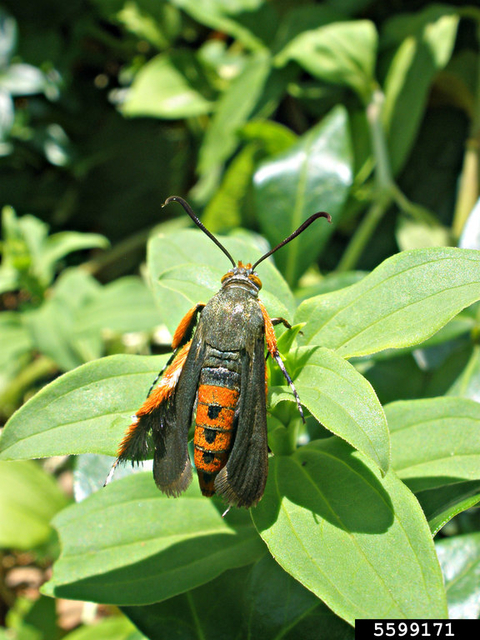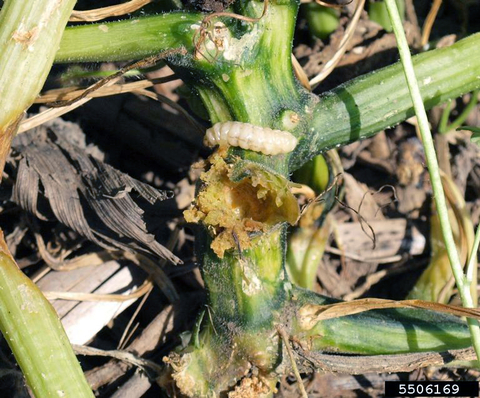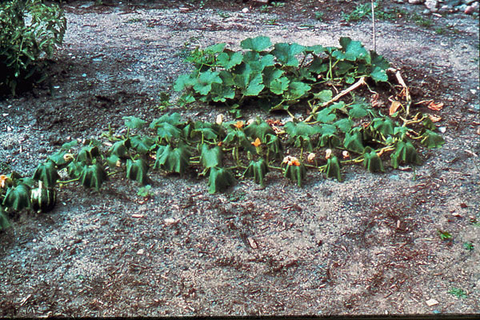Quick facts
- The squash vine borer is a common clearwing moth whose larvae feed inside the vines and crowns of summer squash, winter squash, and pumpkins.
- It is active from mid-June through July.
- In-home gardens and small farms, entire crops may be lost in a year of high borer populations.
- Feeding by larvae causes yellowing of leaves and wilting.
How to identify squash vine borers
Adults
- Adult moths are unique in that they fly during the day and mimic wasps.
- Moths are about 1/2 inch long with an orange abdomen with black dots.
- The first pair of wings are metallic green while the back pair of wings are clear.
- The back wings are folded when they are at rest, and may not be seen clearly.
Eggs and larvae
- Eggs are flat, brown, and about 1/25 inch long.
- The larvae are white or cream-colored with brown heads, growing to almost an inch in length.
Biology
- There is one generation per year.
- Squash vine borer adults emerge in late June or early July, from cocoons in the ground.
- After emerging, squash vine borers lay eggs singly at the base of susceptible plants.
- Eggs hatch in about one week and the resulting larvae bore into stems to feed.
- Larvae feed through the center of the stems, blocking the flow of water to the rest of the plant.
- Larvae feed for four to six weeks, then exit the stems and burrow about one to two inches into the soil to pupate.
- They remain there until the following summer.
Damage caused by squash vine borers
The first symptom of a borer attack is wilting of affected plants.
Wilting may occur only in strong sun at first, but if the problem is left unchecked, the plants eventually collapse and die. If plants are wilted in the morning, they warrant a closer look.
When you look at a wilting plant closely, you might notice holes near the base of the plant.
- These holes are filled with moist greenish or orange sawdust-like material called frass.
- Over time, the base may become mushy or rot away altogether.
- Several borer larvae may attack a single plant.
Managing squash vine borer in home gardens
Squash vine borers are challenging to prevent or manage. Once the larvae invade the stem, it is difficult to treat squash vine borers.
Check your squash for the presence of adult borers starting the last week of June. There are two methods for detecting squash vine borer adults.
- Watch for their activity in the garden. These moths are easily noticed given their distinct black/orange coloration, as well as a rather loud buzzing noise when they fly.
- For trapping, use a container (e.g. pan, pail, bowl) colored yellow and filled with water, and a drop of dish-soap (break surface tension). Squash vine borer adults are attracted to yellow. They will fly to the container and be trapped when they fall into the water.
- Place traps by late June, checking your traps at least once a day.
Once the presence of squash vine borers is confirmed, pick one of the methods to control their population.
Exclusion
Plan your planting schedule carefully
- Plant vine crops that are usually not attacked by squash vine borers, such as butternut squash, cucumbers, melons and watermelons.
- Plant a second planting of summer squash in early July. These plants will mature after adult borers have finished laying eggs and will not suffer any damage.
- Promptly pull and destroy any plants killed by squash vine borers.
Use a physical barrier
Place floating row covers over your vine crops when they start to vine (or for non-vining varieties, starting late June or early July) or when you first detect squash vine borer adults.
- Keep the barriers in place for about two weeks after the first adult borer has been seen.
- Secure the row covers in a way that prevents adults from moving underneath it.
- Don't use row covers if cucurbits were planted in the same area the previous year.
This is because squash vine borers spend the winter in the soil near their host plants. When the adults emerge the following summer, they may be trapped under the row cover instead of being kept out.
- Practice rotation to minimize this issue by planting cucurbits in different areas of your garden (if possible) or alternate seasons when you grow cucurbits.
Caution: Do not use floating row covers anytime crops are flowering. This prevents bees from pollinating your vegetables.
If your crop is still successfully attacked by borers, you can try to kill the borer inside the vine. Keep in mind that you may not be able to save the plant.
- As soon as wilting is noticed, use a sharp knife to cut a slit in the affected stem.
- Slice carefully up the vine until you locate the borer (or borers).
Once you have killed any borers with the tip of the knife, mound moist soil over the cut area and keep this spot well watered. New roots may grow along the cut stem, allowing the plant to survive.
If pesticides are needed, spray or dust the stems at their base.
- Start treatments when vines begin to run (or the last week of June or early July for non-vining varieties) or when the first adult borers are detected.
- Repeat in 7-10 days.
- Two applications help manage most squash vine borer adults.
For more thorough coverage, continue treatments at 7-10 day intervals until the end of July. Common names of active ingredients effective against squash vine borers are carbaryl, permethrin, bifenthrin, and esfenvalerate.
CAUTION: Mention of a pesticide or use of a pesticide label is for educational purposes only. Always follow the pesticide label directions attached to the pesticide container you are using. Be sure that the plant you wish to treat is listed on the label of the pesticide you intend to use. And observe the number of days between pesticide application and when you can harvest your crop. Remember, the label is the law.
Managing squash vine borer on farms
There are pheromone traps available for squash vine borer adults. These traps attract male squash vine borers and can give growers an idea of when adult insects are active in their area. There are no thresholds associated with the traps.
If you do trap, note that the pheromone will also attract relatives of squash vine borer, so brush up on ID before checking traps.
If you had issues with squash vine borer in the previous growing season, make sure to rotate away from the area and destroy crop residue.
There are different levels of squash vine borer resistance among the types of squash. Butternut squash is less susceptible to squash vine borer than Hubbard and acorn squash.
Exclusion
During the season, exclusion can be effective in preventing squash vine borer damage.
- Floating row covers placed over susceptible plants during moth flight will prevent adults from laying eggs.
- Row covers can be placed when crops start to vine or when squash vine borer is flying in your area.
- It is important to anchor the sides of the row cover for effective exclusion.
- Row covers will need to be removed once crops start to flower to allow for pollination.
When using insecticides to control squash vine borer, the goal is to have the product in place when larvae are hatching but before they burrow into the stem of the plant. Once plants are wilting, insecticides will not help unless there are still eggs about to hatch in the field.
As with any pesticide application in vine crops, it is important to be mindful of bees when making applications. Broad-spectrum insecticides may kill bees, and should be avoided during flowering. If sprays are needed during flowering, spray later in the day, preferably during the evening, when bees are less active and flowers of some vine crops will be closed. This will also allow the insecticide residue to dry on foliage before bees re-enter the field the following day.
Note that Bacillus thuringiensis (Bt) is not effective against squash vine borer. Bt needs to be ingested to be effective, and once the larvae are inside the stems, they are protected from most foliar sprays.
Refer to the Midwest Vegetable Production Guide for current product recommendations.
CAUTION: Mention of a pesticide or use of a pesticide label is for educational purposes only. Always follow the pesticide label directions attached to the pesticide container you are using. Be sure that the plant you wish to treat is listed on the label of the pesticide you intend to use. And observe the number of days between pesticide application and when you can harvest your crop. Remember, the label is the law.
Reviewed in 2022




